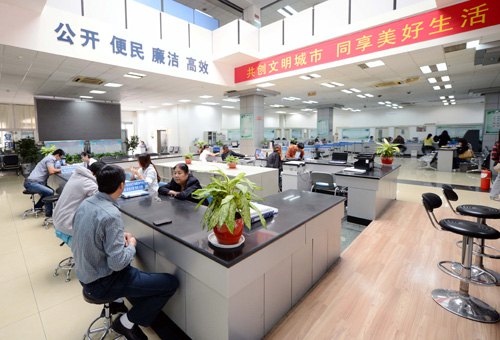|
 |
|
BETTER SERVICE: Citizens go through procedures at the government service hall of Jinan, Shandong Province. China has begun to streamline administration to better serve the economy (ZHU ZHENG) |
A more specific timeframe is also a guarantee for the implementation of the reform plan, said Yang, referring to the 2020 deadline.
Chen Fengying, Director of the Institute of World Economic Studies, China Institutes of Contemporary International Relations, told Beijing Review it's a "miracle" that the CPC has managed to hammer out so many reform tasks within six months.
"Institutional change is of vital significance. Such a change is likely to result in more positive growth expectations for China," said Chen.
Capital Economics, a London-based economic forecaster, said in its latest China Economics Update release that the detailed reform plan is clear, wide-ranging and does not shy away from areas of contention. "China's reform package is beyond expectations," the company said.
Wang Qinwei, an economist at Capital Economics, said the plan was ambitious, well-rounded and in-depth, and that it could offer a cushion for supporting the long-term sustainable growth of the economy.
Giving the market a greater role is viewed as the biggest highlight of the reforms, as China looks to market forces in search of new growth drivers amid prolonged slowdown, said analysts.
For some time right after the founding of the People's Republic in 1949, the idea of a market had been associated with capitalism in China. Even after reform and opening up in late 1978, the country had struggled to define the market and some dogmatists still questioned whether socialism could accommodate a market economy. It was not until the 14th CPC National Congress was held in 1992, that a socialist market economy became a consensus. The Party agreed that the market, under state macroeconomic control, should be the "basic" means of allocating resources.
The Third Plenary Session of the 18th CPC Central Committee took market function to the next-higher level, saying it has a "decisive" role in the allocation of resources.
Impending changes
Yang, deputy head of the Office of the Central Leading Group on Finance and Economic Affairs, said it's not only a change of wording, but more importantly a change of the connotation of a socialist market economy.
The upgrading of the market's role was the biggest highlight of the decision and is a significant theoretical innovation, Yang said.
He said such a change is even on par with the proposal to establish a socialist market economy back in 1992.
"The historic theoretical innovation in 1992 greatly pushed forward China's reform and opening up and economic growth, and so will this innovation," said Yang. "It will greatly unleash growth potential and give China another two decades of growth momentum. It will also help China break free from the middle-income trap."
A new attitude toward the function of market forces has also signaled a pending change in the relationship between the market and the government.
China needs to transform government functions, enhance trust in the government and build a service-oriented government, according to the reform plan.
"Only by clearly defining government functions can the market play a 'decisive' role in distributing resources. The government should have five major functions—macro-control, market regulation, public service, social management and protection of the environment," Yang said.
The new Central Government formed in March has been pushing forward an institutional reform to cut red tape and delegate power to lower levels. So far, it has abolished or transferred 221 administrative approval items to local governments.
Wang Feng, Vice Minister of the State Commission Office for Public Sector Reform, said the Chinese Government will continue to streamline governance and reduce government intervention in the market by abolishing more administrative approvals and transferring supervision to lower-level government bodies.
State-owned enterprises (SOEs) have long been criticized for inefficiency and corruption, making them a target in future reforms.
| 